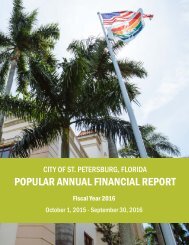FINALTheProposal_WebxPg
You also want an ePaper? Increase the reach of your titles
YUMPU automatically turns print PDFs into web optimized ePapers that Google loves.
12012 interstate traffic conditions indicate there was additional capacity<br />
to accommodate more traffic on I-275 than currently exists in St. Pete,<br />
whereas the two I-275 segments in Tampa and Hillsborough County carried<br />
more traffic than what is considered their maximum capacity under FDOT<br />
standards, and traffic also exceeded capacity on three segments of I-4 in<br />
Tampa and Hillsborough County.<br />
2Four of the top ten 2011 statewide Strategic Intermodal System highway<br />
bottleneck locations were located in Tampa, which include segments of<br />
3<br />
I-275 and I-4; none of the bottleneck segments were located in St. Pete.<br />
Within the Tampa Bay area, the segment of I-275 from State Road 60/<br />
Westshore Blvd to the I-275/I-4 Interchange had the highest segment<br />
crash rate in the Tampa Bay interstate system analysis of crash data<br />
studied by FDOT from 2007 through 2011. In addition to being a safety<br />
concern, frequent crashes contribute to considerable delays during<br />
peak travel periods.<br />
4The January 2015 TBX Study also analyzed projected traffic conditions<br />
for the interstate system in 2040 using the same highway segments as<br />
in 2012 based on “committed capacity”, which is defined as the existing<br />
system plus construction of planned interstate projects through 2020<br />
(note: these conclusions did not assume the Tampa Bay Express<br />
Projects would be implemented by 2040). As a result, all interstate segments<br />
that were analyzed were projected to operate at a level of service “F”, which<br />
means that vehicular demand will exceed the existing and committed capacity<br />
improvements through 2020 if TBX projects are not implemented. By 2040<br />
the situation in Tampa/Hillsborough County would be far worse than St. Pete/<br />
Pinellas County in 2040 if the TBX projects are not implemented. (See figure 2-3,<br />
which shows annual average daily traffic for each interstate segment in 2012 and<br />
2040, if TBX projects are not implemented).<br />
5<br />
The above referenced TBX projects have been funded in the FY 2016-<br />
2017 Work Program for the Pinellas County/St. Pete segments of the<br />
interstate system, which will greatly enhance access to the City of St.<br />
Petersburg’s Tropicana Field site. I-275 will be widened from south of<br />
Traffic Conditions<br />
& Drive Time<br />
Analysis<br />
Gandy Boulevard to north of 4th Street to provide an express lane in each direction. It<br />
is a $102 million project and is being coordinated with the Gateway Express project,<br />
which will be a partially controlled access facility in northern St. Pete and central<br />
Pinellas County. The Gateway Express also has design and construction funding<br />
programmed in FY 2016-2017 in the amount of $346 million. The Gateway Express will<br />
connect I-275 to US 19 and the Bayside Bridge, and enable motorists to travel at higher<br />
speeds on these limited access facilities from downtown St. Pete to areas of central and<br />
northern Pinellas County.<br />
6The Tentative Work Program for Hillsborough County’s TBX projects is<br />
scheduled to be approved in July 2017 and includes the following action<br />
items:<br />
TBX from MLK Blvd. to Busch Blvd. is funded as a design/build project for FY<br />
20/21; The SR 60/275 interchange: right-of-way acquisition has been funded, but no<br />
funds have been committed to-date for construction; TBX projects from Lois Avenue to<br />
Willow Avenue (just east of the SR 60 interchange to just west of downtown Tampa) are<br />
funded as a design/build project for FY 21/22; Design funding is included for proposed<br />
TBX improvements related to the SR 60 interchange in FY 18/19.<br />
This section documents site accessibility from a regional perspective. The Forward Pinellas<br />
planning organization and staff from the City of St. Petersburg’s City Development Administration<br />
have collaborated to provide documentation on 60 minute drive times from downtown St. Pete<br />
to all segments of the Tampa Bay region as previously described earlier in this document. Sixty<br />
minute drive times were utilized because it represents a realistic travel time to measure trips to<br />
major sporting events and major attractions.<br />
Extent of Tampa<br />
Bay Region within a<br />
60 minute drive of<br />
downtown St. Pete<br />
23




